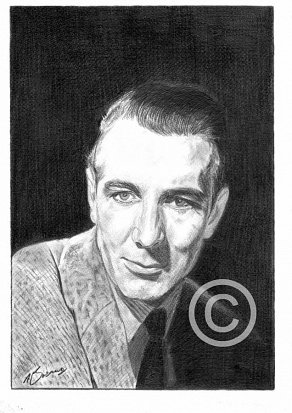Michael Redgrave
Pencil Portrait by Antonio Bosano.

Shopping Basket
The quality of the prints are at a much higher level compared to the image shown on the left.
Order
A3 Pencil Print-Price £20.00-Purchase
A4 Pencil Print-Price £15.00-Purchase
*Limited edition run of 250 prints only*
All Pencil Prints are printed on the finest Bockingford Somerset Velvet 255 gsm paper.
P&P is not included in the above prices.



Comments
Despite a certain chilliness in his film persona, Michael Redgrave had arguably the most sustained screen career of any of the theatrical knights of his day.
His commanding height and good looks made him a natural for the theatre and, after a couple of years as a public school teacher, he became a successful stage actor and an instant film star as the debonair musicologist in Hitchcock’s classic comedy-thriller “The Lady Vanishes”_(1938). Another notable early performance was his portrayal of the idealistic son of the mining family in _“The Stars Look Down” (1939), but there was always perhaps something too cerebral about his film work for easy stardom. Instead, he gave one excellent performance after another, easily sliding into character roles at an age when many stars were still bent on essaying romantic leads.
He was rarely so relaxed in a role again and earned a reputation for playing troubled, neurotic, repressed characters, usually thoughtful, scholarly, intellectual and artistic, whose inner turmoil he was able to express vocally and visually with a wide range of nuance. Perhaps much of this ability reflected his own inner demons included alcoholism and bisexuality, though he was married to actress Rachel Kempson for 50 years and begat two generations of actors.
His illustrious stage career involved seasons with the Old Vic (John Gielgud’s legendary company of 1937-38), Stratford and Chichester, in Shakespeare, Chekhov (a great Uncle Vanya, 1963) and many modern plays, including The Old Boys (1971).
His theatrical CV occupies four columns in Who’s Who in the Theatre (1972), and this, along with about 50 films and plentiful TV, testifies to a crowded career. More articulate than many about the craft of acting – he was the author of two books about it – and of the relative rewards of the various media, he notched up a strikingly versatile run of screen performances.
There were three fine – and notably varied – roles for director Anthony Asquith: as the poetic Flight-Lieutenant who is killed in “The Way to the Stars” (1945), the failed, embittered schoolmaster in “The Browning Version” (1951), and a definitive Jack Worthing in “The Importance of Being Earnest” (1952).
As well he gave brilliant studies in mounting terror as the deranged ventriloquist in Dead of Night (d. Cavalcanti, 1945) and the Air Marshal caught in a nightmare in The Night My Number Came Up (d. Leslie Norman, 1955), delineated movingly the rise in prestige and loss of ideals in the protagonist of Fame Is the Spur (d. Roy Boulting, 1947), and, from the mid 1950s, gave any number of well-wrought character studies. Of these latter, the humane, limited prison governor in The Loneliness of the Long Distance Runner (d. Tony Richardson, 1962) and The Go-Between (d. Joseph Losey, 1971), as ruined old man, are among the most notable.
His late 1940s attempt at a Hollywood star career failed, but he would from time to time appear in US films, including The Quiet American (d. Joseph L. Mankiewicz, 1958).
Tall (6’4”) and imposing, he was bumpily married (there were affairs with both men and women) to Rachel Kempson, and their children, Vanessa, Lynn and Corin Redgrave are all actors, as are his grandchildren, Joely and Natasha Richardson and Jemma Redgrave.